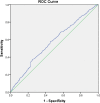Atherogenic index of plasma is an independent predictor of metabolic-associated fatty liver disease in patients with type 2 diabetes
- PMID: 35818084
- PMCID: PMC9275169
- DOI: 10.1186/s40001-022-00731-x
Atherogenic index of plasma is an independent predictor of metabolic-associated fatty liver disease in patients with type 2 diabetes
Abstract
Background: Metabolic-associated fatty liver disease (MAFLD), formerly known as non-alcoholic fatty liver disease, is the leading cause of liver disease that can ultimately lead to cirrhosis. Identifying a screening marker for early diagnosis of MAFLD in patients with type 2 diabetes (T2D) can reduce the risk of morbidity and mortality. This study investigated the association between the atherogenic index of plasma (AIP) and MAFLD in patients with T2D.
Method: A retrospective case-control study was conducted and medical records of patients with T2D were assessed. The baseline characteristics, anthropometric indices, laboratory measurements including liver functions tests, fasting blood sugar, HbA1C, lipid profile were documented.
Results: Out of 2547 patients with T2D, 824 (32.4%) had MAFLD. The multivariate logistic regression analysis showed a significant difference in female-to-male ratio (1.11 vs. 1.33, OR = 0.347, P-value < 0.001), ALT (42.5 ± 28.1 vs. 22.4 ± 11.1, OR = 1.057, P-value < 0.001), and AIP (0.6 ± 0.3 vs. 0.5 ± 0.3, OR = 5.057, P-value < 0.001) between MAFLD and non-MAFLD groups, respectively. According to the AIP quartile, the prevalence of MAFLD increased significantly in patients with higher AIP quartiles (P-value < 0.001). Also, we found a cut-off of 0.54 for AIP in predicting MAFLD in patients with T2D (sensitivity = 57.8%, specificity = 54.4%).
Conclusion: In this study, we found that AIP is a good and independent predictor for MAFLD in patients with T2D which could help physicians in early diagnosis and follow-up of patients with T2D.
Keywords: Atherogenic index of plasma; Diabetes mellitus; Metabolic-associated fatty liver disease; Non-alcoholic fatty liver disease.
© 2022. The Author(s).
Conflict of interest statement
We know of no conflict of interest associated with this publication.
References
-
- European Association for the Study of the Liver (EASL) European Association for the Study of Diabetes (EASD) European Association for the Study of Obesity (EASO) EASL-EASD-EASO clinical practice guidelines for the management of non-alcoholic fatty liver disease. Obes Facts. 2016;9(2):65–90. doi: 10.1159/000443344. - DOI - PMC - PubMed
MeSH terms
Substances
LinkOut - more resources
Full Text Sources
Medical
Miscellaneous


